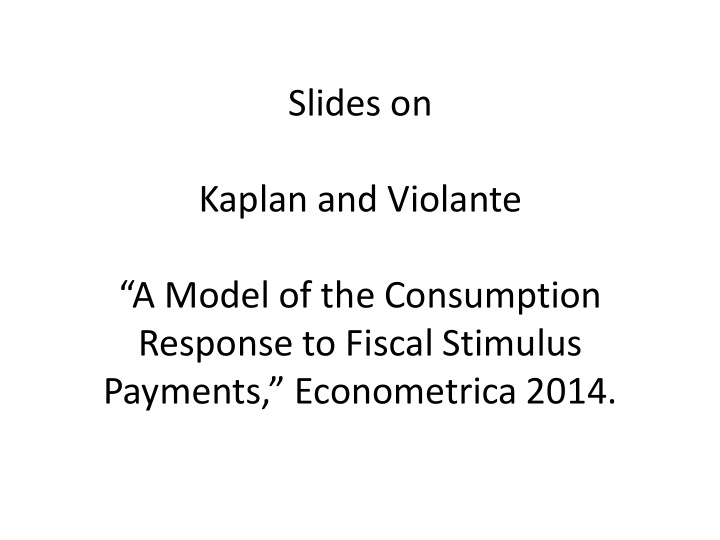



Slides on Kaplan and Violante “ A Model of the Consumption Response to Fiscal Stimulus Payments,” Econometrica 2014.
1. Introduction A. Overview • Paper develops model to explain the estimated responses of consumers to tax rebates. • The implications of the model go far beyond the analysis of tax rebates. They help explain many results from the consumption literature. B. Existing empirical evidence on Effects of Tax Rebates of 2001 and 2007-09 • These were $500 - $1,000 per household • Johnson, Parker, Souleles (2006) and Parker, Souleles, Johnson, and McClelland (2011) exploited randomized timing (last 2 digits of SS #s) to estimate the effects of the rebates. • They tended to find a marginal propensity to consume (MPC) out of the rebate of 25% for nondurables in the quarter when the rebate was received – “ rebate coefficient .” • Standard theory with rational expectations, life cycle, buffer stock model with one risk-free asset predicts a MPC out of transitory income close to 0 in aggregate since micro studies suggest only 10% of households are liquidity constrained based on measures of net worth.
C. What this paper does • Proposes a quantitative framework that explains the results • Integrate classic Baumol-Tobin model of money demand into a partial equilibrium version of the incomplete markets economy. Households can store wealth in 2 instruments: (1) liquid asset (e.g. cash) (2) illiquid asset (housing, retirement account, etc.) Households can also borrow through unsecured credit. • Illiquid asset earns a higher rate of return, but can only be accessed by paying a transaction cost. • Model features a significant number of “ wealthy hand-to-mouth ” households. Using the 2001 Survey of Consumer Finances, they find that 1/3 of US households fit this picture. • In their model, consumers aren’t behaving irrationally. The mechanism is similar to Cochrane (1989) – the utility cost of not smoothing consumption in these cases is second order.
D. More discussion of implications of model and link to literature • The wealthy hand-to-mouth (WHTM) do not respond to news of a rebate and have a high MPC when they receive their payment. • Misra and Surico (2011) estimate entire empirical distribution of consumption responses for 2001 rebate and find ½ of population displays no response at all and 1/5 of population display MPC > 50%. There are high income households in both groups. • The model features a marked size asymmetry with respect to small vs. large lumps of transitory income. Hsieh (2003) found that Alaskans followed LC model for the big annual Alaska Permanent Fund payments (which are often over $1,000 per capita per year) , but showed excess sensitivity to income tax refunds (which are small).
D. More discussion of implications of model and link to literature (cont) • The model demonstrates two useful lessons for policy design: (1) Rebates are more effective in a mild recession A mild recession features small drops in income, so households don’t bother paying the transactions cost, so MPC>0. In a severe recession, income is dropping so much that households are more likely to pay the transactions cost to withdraw funds from the illiquid asset, so MPC = 0. (2) When comparing budget-equivalent policies, to achieve the most bang for your buck, the lump sum rebate should be phased out at the median income. • Model helps explain the Parker et al results: Consumption response of the treatment group (i.e. the group that received the check in a given week) is measured relative to a control group that is composed of (i) households who were aware of the policy but will receive the check later; and (ii) households who have already received the check. The control group’s response is a mix of MPC out of the news and the lagged MPC out of the payment.
(The model will be presented on the board.)
Recommend
More recommend